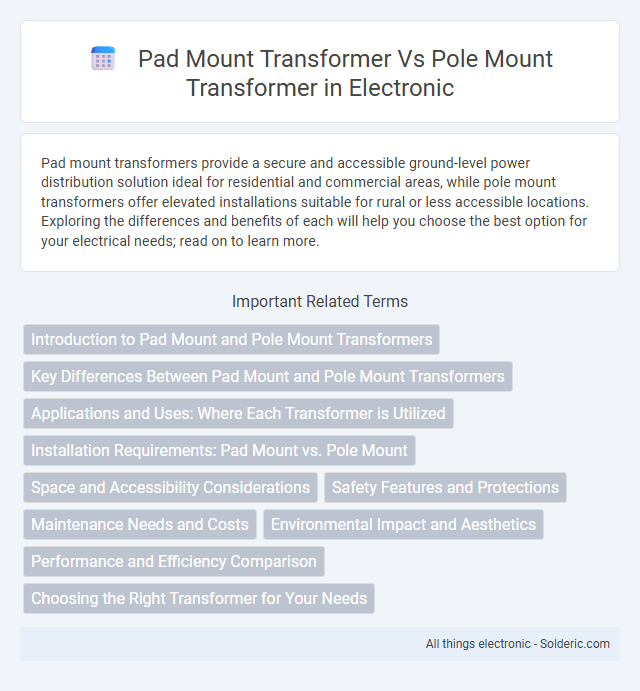Pad mount transformers provide a secure and accessible ground-level power distribution solution ideal for residential and commercial areas, while pole mount transformers offer elevated installations suitable for rural or less accessible locations. Exploring the differences and benefits of each will help you choose the best option for your electrical needs; read on to learn more.
Comparison Table
| Feature | Pad Mount Transformer | Pole Mount Transformer |
|---|---|---|
| Installation Location | Ground level on a concrete pad | Mounted on utility poles |
| Use Case | Urban and suburban underground distribution systems | Rural and overhead power distribution |
| Size and Capacity | Generally larger and higher capacity | Smaller capacity due to pole weight limits |
| Safety | Enclosed, tamper-resistant casing for safety | Elevated, less accessible but exposed to weather |
| Maintenance | Easier ground-level access | Requires climbing poles for inspection |
| Protection from Elements | Protected enclosure, less exposure | Exposed to weather, higher risk of damage |
| Common Voltage Ratings | Up to 35 kV primary voltage | Up to 34.5 kV primary voltage |
| Typical Applications | Residential complexes, commercial buildings | Rural homes, open land distribution |
| Installation Cost | Higher initial cost due to concrete pad and enclosure | Lower initial cost but potential higher maintenance |
Introduction to Pad Mount and Pole Mount Transformers
Pad mount transformers are ground-mounted units enclosed in a secure, weather-resistant steel cabinet typically used in residential and commercial underground distribution systems. Pole mount transformers are elevated on utility poles, designed for overhead power distribution in areas with limited ground space or rugged terrain. Your choice between pad mount and pole mount transformers depends on factors such as installation environment, safety, aesthetics, and maintenance requirements.
Key Differences Between Pad Mount and Pole Mount Transformers
Pad mount transformers are enclosed units installed at ground level within a secure metal or concrete enclosure, designed for easy access and enhanced safety in urban or residential areas. Pole mount transformers are mounted on utility poles, saving ground space and suited for rural or less dense environments where overhead power lines are prevalent. Your choice depends on installation site constraints, safety requirements, and aesthetic considerations.
Applications and Uses: Where Each Transformer is Utilized
Pad mount transformers are commonly used in residential neighborhoods, commercial complexes, and industrial sites for underground electrical distribution, providing a secure and weather-resistant solution at ground level. Pole mount transformers are typically installed on utility poles in rural or suburban areas to supply electricity to homes and businesses where overhead lines are prevalent. Your choice depends on the environment, with pad mount transformers suited for underground systems and pole mount transformers ideal for overhead distribution networks.
Installation Requirements: Pad Mount vs. Pole Mount
Pad mount transformers require a secure, level concrete pad and sufficient clearance for maintenance and safety, typically installed at ground level in urban or suburban areas. Pole mount transformers are elevated on utility poles, necessitating strong poles capable of supporting the unit's weight and clearance from obstructions for safe operation. Your choice depends on site conditions, space availability, and accessibility for installation and future service.
Space and Accessibility Considerations
Pad mount transformers require more ground space but offer easier accessibility for maintenance and inspections compared to pole mount transformers, which save valuable ground area by being elevated on utility poles. Pole mount transformers can be challenging to access due to their height, necessitating specialized equipment such as bucket trucks. The choice between them depends largely on site space availability, safety requirements, and maintenance logistics.
Safety Features and Protections
Pad mount transformers offer enhanced safety features such as tamper-resistant enclosures and underground installation that reduces exposure to weather and accidental contact, ensuring safer environments in residential or commercial areas. Pole mount transformers provide elevated placement that minimizes human contact and potential hazards, though they are more exposed to weather-related damage. Your choice between pad mount and pole mount transformers should consider these protection aspects based on location and risk exposure.
Maintenance Needs and Costs
Pad mount transformers require less frequent maintenance due to their sealed, weather-resistant design, reducing long-term service costs. Pole mount transformers, exposed to environmental factors, demand more regular inspections and repairs, increasing maintenance expenses. The choice impacts operational budgets significantly, with pad mount units offering cost savings through lower upkeep requirements.
Environmental Impact and Aesthetics
Pad mount transformers have a lower visual impact as they are ground-level and can be landscaped or enclosed in decorative housings, minimizing disruption to the natural environment. Pole mount transformers, elevated on utility poles, are more conspicuous and can impact the aesthetics of residential or natural areas, often drawing more visual attention. The environmental impact of pad mount transformers is generally reduced due to fewer exposure-related maintenance issues and less interference with wildlife compared to pole mount transformers.
Performance and Efficiency Comparison
Pad mount transformers offer superior performance in urban and suburban environments due to their enhanced insulation and lower noise levels, making them ideal for residential areas. Pole mount transformers provide efficient energy distribution in rural or less accessible locations, minimizing installation costs and maintenance efforts. Your choice depends on balancing efficiency needs with the physical environment and safety requirements.
Choosing the Right Transformer for Your Needs
Pad mount transformers offer a safer, ground-level installation ideal for residential and commercial areas requiring underground power distribution, while pole mount transformers are suited for overhead power lines in rural or less densely populated regions. Consider factors such as space availability, safety requirements, load capacity, and local utility regulations when choosing between the two. Selecting the appropriate transformer type ensures efficient energy distribution, minimizes maintenance costs, and enhances system reliability.
pad mount transformer vs pole mount transformer Infographic

 solderic.com
solderic.com